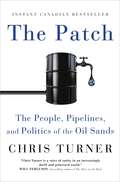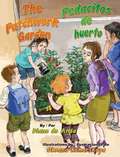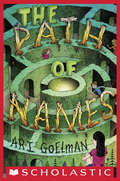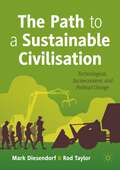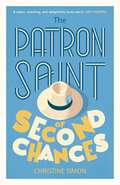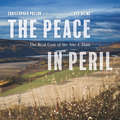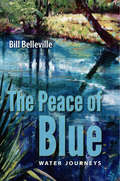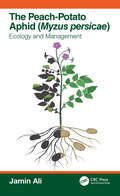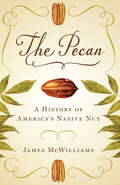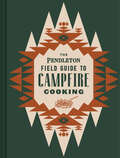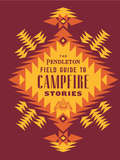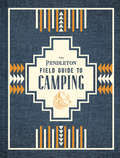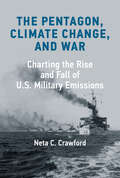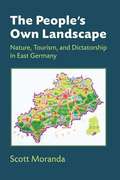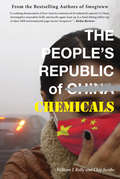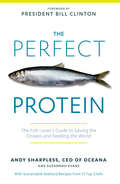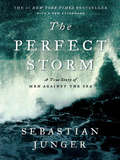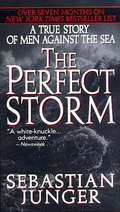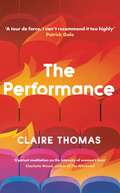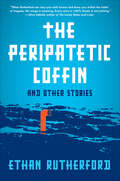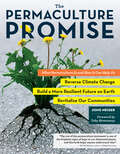- Table View
- List View
The Patch: The People, Pipelines, and Politics of the Oil Sands
by Chris TurnerBestselling author Chris Turner brings readers onto the streets of Fort McMurray, showing the many ways the oilsands impact our lives and demanding that we ask the question: In order to both fuel the world and to save it, what do we do about the Patch?In its heyday, the oilsands represented an industrial triumph and the culmination of a century of innovation, experiment, engineering, policy, and finance. Fort McMurray was a boomtown, the centre of a new gold rush, and the oilsands were reshaping the global energy, political, and financial landscapes. The future seemed limitless for the city and those who drew their wealth from the bitumen-rich wilderness. But in 2008, a new narrative for the oilsands emerged. As financial markets collapsed and the scientific reality of the Patch’s effect on the environment became clear, the region turned into a boogeyman and a lightning rod for the global movement combatting climate change. Suddenly, the streets of Fort McMurray were the front line of a high-stakes collision between two conflicting worldviews—one of industrial triumph and another of environmental stewardship—each backed by major players on the world stage. The Patch is the seminal account of this ongoing conflict, showing just how far the oilsands reaches into all of our lives. From Fort Mac to the Bakken shale country of North Dakota, from Houston to London, from Saudi Arabia to the shores of Brazil, the whole world is connected in this enterprise. And it requires us to ask the question: In order to both fuel the world and to save it, what do we do about the Patch?
The Patchwork Garden / Pedacitos de huerto (Into Reading, Read Aloud Module 8 #3)
by Oksana Kemarskaya Diane AndaNIMAC-sourced textbook <p><p> Tonia loves to listen to her Abuela's stories about when she was a young girl. When her grandmother remembers planting a vegetable garden "on my own little square patch of land," Tonia wishes she too could have her very own garden. Their apartment building is surrounded by cement, but Abuela reminds her that it only takes a small patch of land to grow tomatoes or squash and even carrots. And soon, they have a plan! <p> First, they speak to Father Anselmo about a weed-filled lot behind the church. He likes the idea of beautiful green plants instead of weeds, and fresh vegetables sound delicious too! With help from her family, Tonia yanks out the weeds and plants rows of vegetables. Each day after school, she and Abuela water the seedlings and pull out weeds that have sneaked in between the plants. In a few weeks, "the garden was green with lacy carrot tops in a row, vines of squash curling on the ground and bushy green tomato plants." <p> Tonia loves the garden, but feels sad for all the children who walk by and wish they had a garden of their very own, too. Then her grandmother's quilt gives Tonia an idea. Together they find little plots of land all around the neighborhood for the other children, and soon the community is full of small garden patches that remind Tonia of Abuela's patchwork quilt. <p> With brightly hued illustrations that depict a cityscape full of multiple generations working towards a common goal, children ages 7-10 will be inspired to plant and perhaps even eat!-their own vegetables after reading this charming bilingual picture book.
The Path of Names
by Ari GoelmanMysteries, mazes, and magic combine in this smart, funny summer-camp fantasy -- like THE AMAZING ADVENTURES OF KAVALIER & CLAY for kids!Dahlia Sherman loves magic, and Math Club, and Guitar Hero. She isn't so fond of nature walks, and Hebrew campfire songs, and mean girls her own age.All of which makes a week at summer camp pretty much the worst idea ever. But within minutes of arriving at camp, Dahlia realizes that it might not be as bad as she'd feared. First she sees two little girls walk right through the walls of her cabin. Then come the dreams -- frighteningly detailed visions of a young man being pursued through 1930s New York City. How are the dreams and the girls related? Why is Dahlia the only one who can see any of them? And what's up with the overgrown, strangely shaped hedge maze that none of the campers are allowed to touch? Dahlia's increasingly dangerous quest for answers will lead her right to the center of the maze -- but it will take all her courage, smarts, and sleight-of-hand skills to get her back out again.
The Path to a Sustainable Civilisation: Technological, Socioeconomic and Political Change
by Rod Taylor Mark DiesendorfThe Path to a Sustainable Civilisation shows that we have unwittingly fallen into an existential crisis of our own making. We have allowed large corporations, the military and other vested interests to capture governments and influence public opinion excessively. We have created a god called ‘the market’ and allowed our most important decisions to be made by this imaginary entity, which is in fact a human system controlled by vested interests. The result has been the exploitation of our life support system, our planet, and most of its inhabitants, to the point of collapse. This book argues that the way out of our black hole is to build social movements to apply overwhelming pressure on government and big business, weaken the power of vested interests and strengthen democratic decision-making. This must be done simultaneously with action on the specific issues of climate, energy, natural resources and social justice, in order to transition to a truly sustainable civilisation.
The Patron Saint of Second Chances
by Christine SimonTHE FEEL GOOD NOVEL OF THE YEAR'I loved this funny, heartwarming read' Libby PageThe Patron Saint of Plumbing is not answering Nino Speranza's prayers.Without expensive repairs to the pipes, the water board will cut off Speranza's crumbling Italian village. All 212 inhabitants will be forced to leave.In a desperate bid to find the money to save his hometown, he starts a rumour that Italian heart-throb Dante Rinaldi is coming to town to film his next movie.Soon, the place is teeming with fans and everyone wants to be involved: Speranza's assistant has a screenplay and the butcher will invest - if Speranza can find roles for each of his fifteen enormous sons. Even the priest is on board.It seems the only way to give their beloved town a second chance is to actually make a movie. What could possibly go wrong?Funny, charming and utterly heartwarming, this is the feel-good novel of the year; a celebration of the underdog, of family and of what really matters in life.*'A rare treasure: both hilariously funny and beautifully written.' Julia Claiborne Johnson, author of Better Luck Next Time and Be Frank With Me'The most charming, original and hilarious novel I have read in ages. This novel is something special. Everyone with a sense of humour must pick this up immediately.' Elyssa Friedland, author of Last Summer at The Golden Hotel'A glorious romp of a book with a cast of characters to fall in love with. Gorgeous, hilarious and brimming with joy. Christine Simon's writing is just a delight.' Helen Paris, author of Lost Property'Simon's warm-hearted, original gem of a novel is the feel-good read we all need.' Amy Poeppel, author of Musical Chairs'A charming, fast-paced and warm-hearted farce. Upbeat, escapist and a lot of fun.' Caroline Hulse, author of The Adults
The Peace in Peril: The Real Cost of the Site C Dam
by Ben Nelms Christopher PollonIn the next decade, a 60-metre-high wall of compacted earth will stretch more than a kilometre across the main stem of the Peace River, causing the waters behind it to swell into a 93-square-kilometre artificial lake, drowning the best topsoil left in the BC north. The waters will swallow fifty islands and a valley that is home to farmers, ranchers, trappers and habitat to innumerable creatures big and small.Over four days in late September 2015, Christopher Pollon paddled the 83-kilometre section of the river that will be destroyed by the Site C dam reservoir, accompanied by photojournalist Ben Nelms. Their goal was to witness the very first steps of construction for the almost $8.8-billion project (the most expensive infrastructure project in BC history). They concluded their trip by touring the same stretch by land, interviewing and photographing the locals who stand to lose everything.Equal parts travel adventure, history and journalistic exploration, The Peace in Peril is a story about the dubious trade-off of hydro power for resources like timber and farmland, but also far more: the Peace valley has been a prosperous home to people for eleven thousand years. How will lives, human and otherwise, be erased or irrevocably altered when the next great flood rises up to engulf the Peace River valley?
The Peace of Blue: Water Journeys
by Bill BellevilleThe Earth’s surface is mostly oceans, the human body is approximately 60% water, and the human imagination has been captivated by this life-giving, life-sustaining liquid from time immemorial.According to Carl Hiaasen, Bill Belleville “writes gorgeously and straight from the heart. In The Peace of Blue, the documentarian and nature writer guides you on a lyrical journey to the natural places in Florida and the Caribbean that have been forged and shaped by water. He poetically underscores the vitality of this most essential substance in our lives by showing the many ways in which water-driven landscapes nurture plants, wildlife—and the human spirit.Experience the thrill of traveling to the remote islands of Cuba and to sacred cenotes in the Dominican Republic. Contemplate the shores of Florida’s rivers and lakes and marvel at swamps and seepage slopes. Immerse yourself in the underwater world of clear, fresh springs, and dive into the deep karst caves that are worlds unto themselves.Through adventure and contemplative excursions, Belleville shares his contagious respect—and awe—for the singularity and transcendence of the natural world. We are companions in his search for a distinct sense of place, fellow journeymen in his quest to discover within the watery depths a greater awareness that informs and shapes our common identity.
The Peach Potato Aphid (Myzus persicae): Ecology and Management
by Jamin AliConsidered as economically significant pests with worldwide distribution, aphids feed on hundreds of cultivated and ornamental plants and cause considerable economic loss on a global scale. The peach-potato aphid, Myzus persicae, is one of the most severe model aphid pests and successfully colonizes hundreds of plant species from 40 different families. It is a complex aphid pest known for its high reproductive rate, biotype formation, suppression of plant defenses, and wide range of host plants. This book covers ecological aspects - including life cycle, damage, and host range - which make aphids an economically important pest. A wide range of topics are covered, including ecological aspects of M. persicae; challenges with management approaches; damage; suppression of plant defenses; evolution; the mechanism of resistance against major classes of insecticides; the potential of biological control and natural plant-derived compounds (plant defense elicitors) as an alternative to the use of synthetic chemical insecticides to control M. persicae; and integrated pest management for M. persicae. As the peach-potato aphid is a model aphid pest, studying it helps to develop control strategies against the entire group of aphids. Written for professionals, as well as students, teachers, and researchers in the fields of entomology, ecology, and bioscience, this book is an enriching new addition to its field.
The Pecan: A History of America's Native Nut
by James McWilliamsWhat would Thanksgiving be without pecan pie? New Orleans without pecan pralines? Southern cooks would have to hang up their aprons without America’s native nut, whose popularity has spread far beyond the tree’s natural home. But as familiar as the pecan is, most people don’t know the fascinating story of how native pecan trees fed Americans for thousands of years until the nut was “improved” a little more than a century ago—and why that rapid domestication actually threatens the pecan’s long-term future. In The Pecan, acclaimed writer and historian James McWilliams explores the history of America’s most importantThis lively history by the acclaimed author of Just Food and A Revolution in Eating follows the pecan from primordial Southern groves to the contemporary Chinese marketplace to reveal how a nut with a very limited natural range has become a global commodity and endangered heirloom. commercial nut. He describes how essential the pecan was for Native Americans—by some calculations, an average pecan harvest had the food value of nearly 150,000 bison. McWilliams explains that, because of its natural edibility, abundance, and ease of harvesting, the pecan was left in its natural state longer than any other commercial fruit or nut crop in America. Yet once the process of “improvement” began, it took less than a century for the pecan to be almost totally domesticated. Today, more than 300 million pounds of pecans are produced every year in the United States—and as much as half of that total might be exported to China, which has fallen in love with America’s native nut. McWilliams also warns that, as ubiquitous as the pecan has become, it is vulnerable to a “perfect storm” of economic threats and ecological disasters that could wipe it out within a generation. This lively history suggests why the pecan deserves to be recognized as a true American heirloom.
The Pecan: A History of America's Native Nut
by James McwilliamsWhat would Thanksgiving be without pecan pie? New Orleans without pecan pralines? Southern cooks would have to hang up their aprons without America's native nut, whose popularity has spread far beyond the tree's natural home. But as familiar as the pecan is, most people don't know the fascinating story of how native pecan trees fed Americans for thousands of years until the nut was "improved" a little more than a century ago-and why that rapid domestication actually threatens the pecan's long-term future. In The Pecan, acclaimed writer and historian James McWilliams explores the history of America's most important commercial nut. He describes how essential the pecan was for Native Americans-by some calculations, an average pecan harvest had the food value of nearly 150,000 bison. McWilliams explains that, because of its natural edibility, abundance, and ease of harvesting, the pecan was left in its natural state longer than any other commercial fruit or nut crop in America. Yet once the process of "improvement" began, it took less than a century for the pecan to be almost totally domesticated. Today, more than 300 million pounds of pecans are produced every year in the United States-and as much as half of that total might be exported to China, which has fallen in love with America's native nut. McWilliams also warns that, as ubiquitous as the pecan has become, it is vulnerable to a "perfect storm" of economic threats and ecological disasters that could wipe it out within a generation. This lively history suggests why the pecan deserves to be recognized as a true American heirloom.
The Pendleton Field Guide to Campfire Cooking
by Pendleton Woolen MillisFrom beloved heritage brand Pendleton comes this collection of delicious, family-friendly recipes to elevate any outdoor excursion.Brimming with Pendleton's signature patterns and timeless wisdom, this handsome book is a wonderful companion for families and friends who love spending time in nature. Discover expert tips on how to prep ingredients ahead of time, easily transport supplies, and cook over an open fire or camping stove. Come together around the campfire with more than 30 delicious recipes for outdoor adventures, including:• Skillet Hash with Sausage and Eggs• Campfire Grilled Pizza• Charred Corn Salad with Spices• Pendleton Campfire Popcorn• Giant Snickerdoodle S'mores• And so much more.BELOVED BRAND: For over 150 years, Pendleton Woolen Mills has been one of America's most beloved heritage brands. Known for their woolen blankets and clothing, they are celebrated by people who love the great outdoors.FAMILY FUN: These family-friendly recipes are the perfect way to bring everyone together before a day of adventure or after a day of fun in the outdoors. Making the dishes together is an easy activity for everyone to participate in and offers tons of opportunities to bond with family or friends.BEAUTIFUL TO DISPLAY: Featuring more than 30 delicious, filling recipes in a hardcover package with a cloth cover and lovely textured details, this eye-catching book is the perfect accessory for any outdoor occasion or mountain home and makes for a wonderful gift for those who enjoy the natural world.Perfect for:• Fans of Pendelton• Fans of nature, campers, and the outdoors• Summertime vacationers• Families who love to travel
The Pendleton Field Guide to Campfire Stories
by Pendleton Woolen MillsFrom beloved American heritage brand Pendleton comes this collection of family-friendly tales of adventure and discovery in the wilderness.This captivating collection of campfire stories is the perfect companion for anyone who enjoys the outdoors. These pages present a range of tales, including daring feats of endurance and strength, epic journeys through new frontiers, and exhilarating encounters with wild animals, plus spooky myths to bring campers closer together around the fire.Readers will discover works by beloved naturalists John Muir and Henry David Thoreau, modern tales of adventure from Alex Honnold and Cheryl Strayed, and accounts of bravery and heroism from the adventures of Shackleton and the Donner party. With a combination of awe-inspiring stories and Pendleton's beloved patterns and engaging illustrations throughout, this handsome campfire collection is the ideal addition to any adventure and a wonderful gift for families and friends who love camping.• BELOVED BRAND: For over 150 years, Pendleton Woolen Mills has been one of America's most beloved heritage brands. Known for their woolen blankets and clothing, their products are celebrated by people who love the great outdoors. This thoughtfully curated collection speaks to Pendleton's fans with stories that will elevate any adventure.• FAMILY FUN: These family-friendly stories are the perfect way to bring everyone together after a day of fun outdoors. Reading the stories together is an easy activity for everyone to participate in, and offers tons of opportunities to bond with family or friends.Perfect for:• Fans of Pendleton• Campers, nature lovers, and cabin owners
The Pendleton Field Guide to Camping
by Pendleton Woolen MillsFrom the beloved American heritage brand, The Pendleton Field Guide to Camping is a helpful companion for outdoor enthusiasts and weekend adventurers. Organized into three sections, this handbook offers practical advice on where to go camping, how to go camping, and how to enjoy it once you're there.The Pendleton Field Guide to Camping begins with a brief overview of the best parks and trails in the United States. The second section contains camp essentials—what to pack and how to plan your camping trip—and the final section contains a series of how-tos.• Entries include a brief history of national parks, packing lists, and step-by-step tutorials for starting a fire, pitching a tent, and brewing a cup of coffee in the wilderness.• Filled with tried-and-true advice, illustrations, and informative text• An inviting and instructive tool for anyone who wants to explore the great outdoorsWhether you're an avid outdoorsperson, a weekend explorer, or an aspirational adventurer, this handbook will inspire you to pack a bag and spend some time in the wilderness.For over 150 years, Pendleton Woolen Mills has been one of America's most beloved heritage brands. Known for their woolen blankets and clothing, their products are revered by those who love the great outdoors.• An inviting and instructive tool for those who want to start sleeping under the stars• Great book for Pendleton fans, outdoorsy types, and longtime campers and first-timers alike• Add it to the shelf with books like Bushcraft 101: A Field Guide to the Art of Wilderness Survival by Dave Canterbury, Norwegian Wood: Chopping, Stacking, and Drying Wood the Scandinavian Way by Lars Mytting, and How to Stay Alive in the Woods: A Complete Guide to Food, Shelter and Self-Preservation Anywhere by Bradford Angier
The Penguin of Ilha Grande: From Animal Rescue to Extraordinary Friendship
by Shannon EarleA man rescues a penguin off the coast of Brazil and finds a lifelong connection in this delightful true story about the power of friendship.When an oil-covered penguin washes up in Brazil, Seu João saves the penguin's life. Soon man and penguin are friends, and Dindim the penguin won't return to the wild. At last Dindim swims away, only to return four months later! For seven years, Dindim the penguin lived with Seu João in Brazil for eight months a year, disappearing for four months after his annual molting. Readers will enjoy discovering the wildlife of Brazil while learning about the impacts of oil spills and the importance of conservation. This inspiring, true account of real and unusual friendships is sure to win the hearts of nature and animal lovers alike.
The Pentagon, Climate Change, and War: Charting the Rise and Fall of U.S. Military Emissions
by Neta C. CrawfordHow the Pentagon became the world&’s largest single greenhouse gas emitter and why it&’s not too late to break the link between national security and fossil fuel consumption.The military has for years (unlike many politicians) acknowledged that climate change is real, creating conditions so extreme that some military officials fear future climate wars. At the same time, the U.S. Department of Defense—military forces and DOD agencies—is the largest single energy consumer in the United States and the world&’s largest institutional greenhouse gas emitter. In this eye-opening book, Neta Crawford traces the U.S. military&’s growing consumption of energy and calls for a reconceptualization of foreign policy and military doctrine. Only such a rethinking, she argues, will break the link between national security and fossil fuels. The Pentagon, Climate Change, and War shows how the U.S. economy and military together have created a deep and long-term cycle of economic growth, fossil fuel use, and dependency. This cycle has shaped U.S. military doctrine and, over the past fifty years, has driven the mission to protect access to Persian Gulf oil. Crawford shows that even as the U.S. military acknowledged and adapted to human-caused climate change, it resisted reporting its own greenhouse gas emissions. Examining the idea of climate change as a &“threat multiplier&” in national security, she argues that the United States faces more risk from climate change than from lost access to Persian Gulf oil—or from most military conflicts. The most effective way to cut military emissions, Crawford suggests provocatively, is to rethink U.S. grand strategy, which would enable the United States to reduce the size and operations of the military.
The People's Own Landscape: Nature, Tourism, And Dictatorship In East Germany
by Scott MorandaEast Germany’s Socialist Unity Party aimed to placate a public well aware of the higher standards of living enjoyed elsewhere by encouraging them to participate in outdoor activities and take vacations in the countryside. Scott Moranda considers East Germany’s rural landscapes from the perspective of both technical experts (landscape architects, biologists, and physicians) who hoped to dictate how vacationers interacted with nature, and the vacationers themselves, whose outdoor experience shaped their understanding of environmental change. As authorities eliminated traditional tourist and nature conservation organizations, dissident conservationists demanded better protection of natural spaces. At the same time, many East Germans shared their government’s expectations for economic development that had real consequences for the land. By the 1980s, environmentalists saw themselves as outsiders struggling against the state and a public that had embraced mainstream ideas about limitless economic growth and material pleasures.
The People's Republic of Chemicals
by Chip Jacobs William J. KellyMaverick environmental writers William J. Kelly and Chip Jacobs follow up their acclaimed Smogtown with a provocative examination of China's ecological calamity already imperling a warming planet. Toxic smog most people figured was obsolete needlessly kills as many there as the 9/11 attacks every day, while sometimes Grand Canyon-sized drifts of industrial particles aloft on the winds rain down ozone and waterway-poisoning mercury in America. In vivid, gonzo prose blending first-person reportage with exhaustive research and a sense of karma, Kelly and Jacobs describe China's ancient love affair with coal, Bill Clinton's blunders cutting free-trade deals enabling the U.S. to "export" manufacturing emissions to Asia in a shift that pilloried the West's middle class, Communist Party manipulation of eco-statistics, the horror of "Cancer Villages," the deception of the 2008 Beijing Olympics and spellbinding "peasant revolts" against cancer-spreading plants involving thousands in mostly censored melees. Ending with China's monumental coal-bases decried by climatologists as a global warming dagger, The People's Republic of Chemicals names names and stresses humans over bloodless numbers in a classic sure to ruffle feathers as an indictment of money as the real green that not even Al Gore can deny.
The Peregrine Returns: The Art and Architecture of an Urban Raptor Recovery
by Mary Hennen Peggy Macnamara Stephanie WarePeregrine falcons have their share of claims to fame. With a diving speed of over two hundred miles per hour, these birds of prey are the fastest animals on earth or in the sky, and they are now well known for adapting from life on rocky cliffs to a different kind of mountain: modern skyscrapers. But adaptability only helps so much. In 1951, there were no peregrines left in Illinois, for instance, and it looked as if the species would be wiped out entirely in North America. Today, however, peregrines are flourishing. In The Peregrine Returns, Mary Hennen gives wings to this extraordinary conservation success story. Drawing on the beautiful watercolors of Field Museum artist-in-residence Peggy Macnamara and photos by Field Museum research assistant Stephanie Ware, as well as her own decades of work with peregrines, Hennen uses a program in Chicago as a case study for the peregrines’ journey from their devastating decline to the discovery of its cause (a thinning of eggshells caused by a by-product of DDT), through to recovery, revealing how the urban landscape has played an essential role in enabling falcons to return to the wild—and how people are now learning to live in close proximity to these captivating raptors. Both a model for conservation programs across the country and an eye-opening look at the many creatures with which we share our homes, this richly illustrated story is an inspiring example of how urban architecture can serve not only our cities’ human inhabitants, but also their wild ones.
The Perfect Protein: The Fish Lover's Guide to Saving the Oceans and Feeding the World
by Andy Sharpless Suzannah EvansThe planet will be home to more than 9 billion people by 2050, and we're already seeing critical levels of famine around the world mirrored by growing obesity in developed nations. In The Perfect Protein, Andy Sharpless maintains that protecting wild seafood can help combat both issues, because seafood is the healthiest, cheapest, most environmentally friendly source of protein on earth. While the conservation community has taken a simplistic, save-the-whales approach when it comes to oceans, Sharpless contends that we must save the world's seafood not just to protect marine life and biodiversity but to stave off the coming humanitarian crisis. With high demand for predator species like tuna and salmon, wealthy nations like the U.S. convert "reduction" species such as anchovies, mackerel, and sardines into feed for salmon and other farmed animals—even though these overlooked fish are packed with health-boosting Omega-3 fatty acids and could feed millions. By establishing science-based quotas, protecting wild habitats, and reducing bycatch (and treating anchovies and their like as food, not feed), Sharpless believes that effective ocean stewardship can put healthy, sustainable seafood on the table forever. To that end, Oceana has tapped 20-plus chefs, including Mario Batali, Eric Ripert, and Jose Andres for recipes that give us all a role to play in this revolutionary mission: to save the fish so that we can eat more fish.
The Perfect Storm: A True Story Of Men Against The Sea
by Sebastian JungerThere is nothing imaginary about Junger's book; it is all terrifyingly, awesomely real.--Los Angeles Times It was the storm of the century, boasting waves over one hundred feet high--a tempest created by so rare a combination of factors that meteorologists deemed it "the perfect storm." In a book that has become a classic, Sebastian Junger explores the history of the fishing industry, the science of storms, and the candid accounts of the people whose lives the storm touched. ?The Perfect Storm? is a real-life thriller that makes us feel like we've been caught, helpless, in the grip of a force of nature beyond our understanding or control.
The Perfect Storm: A True Story of Men Against the Sea
by Sebastian JungerThe bestselling book that became the blockbuster film starring George Clooney, Mark Wahlberg, and Diane Lane.<P> In October 1991, three weather systems collided off the coast of Nova Scotia to create a storm of singular fury, boasting waves over one hundred feet high. Among its victims was the Gloucester, Massachusetts-based swordfishing boat the Andrea Gail, which vanished with all six crew members aboard.<P> "Drifting down on swimmers is standard rescue procedure, but the seas are so violent that Buschor keeps getting flung out of reach. There are times when he's thirty feet higher than the men trying to rescue him. . . . [I]f the boat's not going to Buschor, Buschor's going to have to go to it. SWIM! they scream over the rail. SWIM! Buschor rips off his gloves and hood and starts swimming for his life."<P> It was the storm of the century, boasting waves over one hundred feet high a tempest created by so rare a combination of factors that meteorologists deemed it "the perfect storm." When it struck in October 1991, there was virtually no warning. "She's comin' on, boys, and she's comin' on strong," radioed Captain Billy Tyne of the Andrea Gail off the coast of Nova Scotia, and soon afterward the boat and its crew of six disappeared without a trace. <P> In a book taut with the fury of the elements, Sebastian Junger takes us deep into the heart of the storm, depicting with vivid detail the courage, terror, and awe that surface in such a gale. Junger illuminates a world of swordfishermen consumed by the dangerous but lucrative trade of offshore fishing, "a young man's game, a single man's game," and gives us a glimpse of their lives in the tough fishing port of Gloucester, Massachusetts; he recreates the last moments of the Andrea Gail crew and recounts the daring high-seas rescues that made heroes of some and victims of others; and he weaves together the history of the fishing industry, the science of storms, and the candid accounts of the people whose lives the storm touched, to produce a rich and informed narrative. The Perfect Storm is a real-life thriller that will leave readers with the taste of salt air on their tongues and a sense of terror of the deep.
The Performance: A Novel
by Claire Thomas'Quietly transformational'The Times 'A tour de force... I can't recommend this too highly'Patrick Gale'Innovative... an original, at-a-sitting read'Daily Mail'A potent meditation on the intensity of women's lives'Charlotte Wood, author of The Weekend'A miracle... Engaging and evocative'Washington Post'I loved and admired The Performance... Unmissable'Emma Stonex, author of The Lamplighters'Lively and intimate... The way Thomas plays with the reader is a sort of genius'Guardian'Thomas writes these women with such wisdom and compassion, that by the end we are all transformed'Claire Fuller, author of Unsettled Ground The false cold of the theatre makes it hard to imagine the heavy wind outside in the real world, the ash air pressing onto the city from the nearby hills where bushfires are taking hold.The house lights lower.The auditorium feels hopeful in the darkness.As bushfires rage outside the city, three women watch a performance of a Beckett play.Margot is a successful professor, preoccupied by her fraught relationship with her ailing husband. Ivy is a philanthropist with a troubled past, distracted by the snoring man beside her. Summer is a young theatre usher, anxious about the safety of her girlfriend in the fire zone.As the performance unfolds, so does each woman's story. By the time the curtain falls, they will all have a new understanding of the world beyond the stage.
The Peripatetic Coffin: and Other Stories
by Ethan RutherfordThe stories in The Peripatetic Coffin and Other Stories, a collection from Ethan Rutherford, map the surprising ways in which the world we think we know can unexpectedly reveal its darker contours.In stories that are alternately funny, persuasive, and compelling, unforgettable characters are confronted with, and battle against, the limitations of their lives.Rutherford’s work has been selected by Alice Sebold for inclusion in the volume of The Best American Short Stories that she edited, and also published in Ploughshares, One Story, and American Short Fiction.
The Permaculture Promise: What Permaculture Is and How It Can Help Us Reverse Climate Change, Build a More Resilient Future on Earth, and Revitalize Our Communities
by Toby Hemenway Jono NeigerPermaculture is a sustainability buzzword, but many people wonder what it actually means and why it is relevant. Originally coined by combining the words permanent and agriculture, permaculture has evolved into an optimistic approach connecting all the systems of human life: gardening, housing, transportation, energy, and how we structure our communities. The Permaculture Promise explains in simple terms why permaculture may be the key to unlocking a livable future on our planet. Author Jono Neiger asserts that humans can thrive while simultaneously making Earth healthier and not destroying it. The book shows 22 ways that permaculture can create a better future for all living things. Profiles of people and communities — including an urban dweller who tore up her driveway to create a vegetable garden and a California housing development that dedicates a third of its land to parks, orchards, and gardens — will inspire you to incorporate permaculture principles into your life today.
